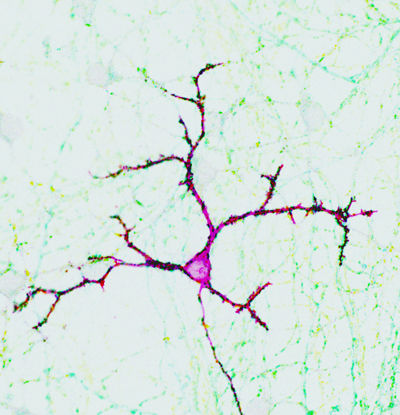New regulator discovered for information transfer in the brain
The protein mSYD1 has a key function in transmitting information between neurons. This was recently discovered by the research group of Prof Peter Scheiffele at the Biozentrum, University of Basel. The findings of the investigations have been published in the scientific journal “Neuron”.

Neuron with synaptic contacts.
Biozentrum
Synapses are the most important sites of information transfer between neurons. The functioning of our brain is based on the ability of the synapses to release neurotransmitter substances in a fraction of a second, so that neuronal signals can be rapidly propagated and integrated. Peter Scheiffele’s team has now identified a new mechanism, which ensures that synaptic vesicles, the carrier of the transmitter substances, are concentrated at their designated place, thereby contributing to rapid signal transmission.
mSYD1 as organizer of synaptic structures
The speed and precision of synaptic transmission is based on a highly complex protein apparatus in the synapse. A concentration of synaptic vesicles is found at the synaptic contact sites between neurons. When a nerve cell is activated, vesicles fuse with the edge of the synapse, the so-called active zone, and send neurotransmitters to the neighboring cells.
Peter Scheiffele’s research group has now identified a previously unknown protein called mSYD1, which regulates the deposition of the vesicles at the active zone. In nerve cells, in which no mSYD1 protein is present, synaptic contacts continue to be formed but the accumulation of the synaptic vesicles at the active zone is disrupted. This results in a significant reduction of synaptic transmission.
Inactive mSYD1 in autistic disorders
These findings provide important new insights into the mechanisms underlying the formation of functional neuronal networks. In patients with a developmental disorder belonging the autism spectrum, mSYD1 is one of a group of genes that are inactivated. In further investigations, the research group is now looking at how the inactivation of mSYD1 affects the behavior of mice, in order to gain insights into the fundamental neuronal defects associated with autism.
Original publication
Corinna Wentzel, Julia Sommer, et al., mSYD1A, a Mammalian Synapse-Defective-1 Protein, Regulates Synaptogenic Signaling and Vesicle Docking. Neuron; Published online June 19, 2013.
Most read news
Original publication
Corinna Wentzel, Julia Sommer, et al., mSYD1A, a Mammalian Synapse-Defective-1 Protein, Regulates Synaptogenic Signaling and Vesicle Docking. Neuron; Published online June 19, 2013.
Organizations
Other news from the department science

Get the life science industry in your inbox
By submitting this form you agree that LUMITOS AG will send you the newsletter(s) selected above by email. Your data will not be passed on to third parties. Your data will be stored and processed in accordance with our data protection regulations. LUMITOS may contact you by email for the purpose of advertising or market and opinion surveys. You can revoke your consent at any time without giving reasons to LUMITOS AG, Ernst-Augustin-Str. 2, 12489 Berlin, Germany or by e-mail at revoke@lumitos.com with effect for the future. In addition, each email contains a link to unsubscribe from the corresponding newsletter.





















































